Modification of the Peck Formula for a Double-Track Shield Tunnel under Expressway Subgrade
Abstract
:1. Introduction
2. Finite Element Calculation and Field Monitoring of a Subgrade Settlement
2.1. Project Overview
2.2. Finite Element Calculation
2.3. On-Site Monitoring of the Subgrade Settlement
3. Analysis of the Subgrade Settlement Law
3.1. Calculation of the Peck Empirical Formula
3.2. Modified Peck Empirical Formula
3.2.1. Linear Regression
3.2.2. Introducing the Correction Parameters
4. Validation of Similar Projects
4.1. Classical Peck Formula Calculation
4.2. Modified Peck Formula Calculation
4.3. Comparative Analysis of the Data
5. Conclusions
- (1)
- In the construction of a double-track shield tunnel under an expressway subgrade section, the finite element calculation model based on actual engineering parameters can reflect the law of surface settlement in the construction process.
- (2)
- In the construction of the shield tunnel under the expressway subgrade section, there is a large error between the surface settlement value calculated based on the classic Peck formula and the actual monitoring data during construction.
- (3)
- The settlement of the subgrade surface caused by the excavation of the preceding tunnel and the subsequent tunnel was analyzed and fitted. By introducing two correction parameters (the soil loss rate and settlement groove width coefficient), the modified Peck empirical formulas applicable to the preceding tunnel (α1 ≈ 0.38 and β1 ≈ 2.08) and the subsequent tunnel (α2 ≈ 0.29 and β2 ≈ 1.99) were proposed. The results showed that the modified formula more effectively described the surface lateral settlement caused by the double-line shield tunnel through the highway subgrade section.
- (4)
- By introducing a similar project for verification, the reliability of the modified Peck empirical formula was verified. This had a certain engineering reference value and reflected the limitations of the modified formula. For other projects, it will be necessary to modify the model according to the specific engineering situation.
- (5)
- This paper takes the project of a double-track shield tunnel undercrossing highway subgrade as the research object, puts forward the modified Peck calculation formula suitable for this project, and summarizes the relevant conclusions, which can provide a certain reference value for the design and construction of similar projects.
Author Contributions
Funding
Conflicts of Interest
References
- Zhu, C.H. Control of surface settlement by considering shield tunneling technology. KSCE J. Civ. Eng. 2017, 21, 2896–2907. [Google Scholar] [CrossRef]
- Duan, S.K.; Huang, L.; Bao, Z.; Shen, P. Application of modified Peck formula in surface subsidence prediction of Changsha subway tunnel construction. J. Nat. Disasters 2013, 24, 164–169. [Google Scholar]
- Li, X.; Zhang, D.; Hou, Y. Analysis of Shield Tunnel Ground Deformation Characteristics and Affecting Factors in Water-Rich Soft Stratum: A Case Study on the Section Tunnel of Tianjin Metro Line 6. Appl. Sci. 2022, 12, 6208. [Google Scholar] [CrossRef]
- Lei, M.F.; Lin, D.Y.; Shi, C.H.; Yang, W.C. A structural calculation model of shield tunnel segment: Heterogeneous equivalent beam model. Adv. Civ. Eng. 2018, 2018, 9637838. [Google Scholar] [CrossRef]
- Tan, Z.; Li, Z.; Tang, W.; Chen, X.; Duan, J. Research on Stress Characteristics of Segment Structure during the Construction of the Large-Diameter Shield Tunnel and Cross-Passage. Symmetry 2020, 12, 1246. [Google Scholar] [CrossRef]
- Spyridis, P.; Bergmeister, K. Analysis of lateral openings in tunnel linings. Tunn. Undergr. Space Technol. 2015, 50, 376–395. [Google Scholar] [CrossRef]
- Sun, J.C.; Zhang, H.; Peng, T.; Xiao, C.L. Research on Construction Mechanical Behaviour of Connecting Aisle in Shield Tunnel. IOP Conf. Ser. Earth Environ. Sci. 2018, 167, 012041. [Google Scholar] [CrossRef]
- Lu, P.; Yuan, D.; Luo, W.; Jin, D.; Liu, M. Centrifugal Model Test Study on the Mechanical Characteristics of Shield Tunnels Influenced by Different Types of Openings for Cross Passages. Appl. Sci. 2022, 12, 6421. [Google Scholar] [CrossRef]
- Xuan, H.; Ning, L.I.; Standing, J.R. An adaptability study of Gaussian equation applied to predicting ground settlements induced by tunneling in China. Rock Soil Mech. 2007, 1, 23–28+35. [Google Scholar] [CrossRef]
- Fang, E.; Yang, L.; Li, P. Prediction of Ground Settlement Induced by Metro Shield Construction Based on the Modified Peck Formula. Mod. Tunn. Technol. 2015, 52, 143–149+162. [Google Scholar] [CrossRef]
- Junju, T.; Kun, Z.; Song, C.; Yachong, X.; Peixin, Z. Inversion Analysis of Peck Formula Based on Zhengzhou Subway Running Down the Main Channel of South-to-North Water Transfer. Saf. Environ. Eng. 2021, 28, 109–113+132. [Google Scholar] [CrossRef]
- Yusheng, S.; Yonghui, H.; Le, Z.; He, W. Improvement of Peck formula of surface construction settlement of rectangular tunnel in soft soil area. J. Railw. Sci. Eng. 2017, 14, 1270–1277. [Google Scholar] [CrossRef]
- Bracegirdle, A.; Mair, R.J.; Taylor, R.N. Subsurface settlement profiles above tunnels in clays. Géotechnique 1993, 43, 315–320. [Google Scholar]
- Gang, W. Selection and distribution of ground loss ratio induced by shield tunnel construction. Chin. J. Geotech. Eng. 2010, 32, 1354–1361. [Google Scholar]
- Peixian, Q. Deformation Law and Control Strategy of the Subgrade under Shield Crossing High Railway. Master’s Thesis, Anhui Jianzhu University, Hefei, China, 2021. [Google Scholar] [CrossRef]
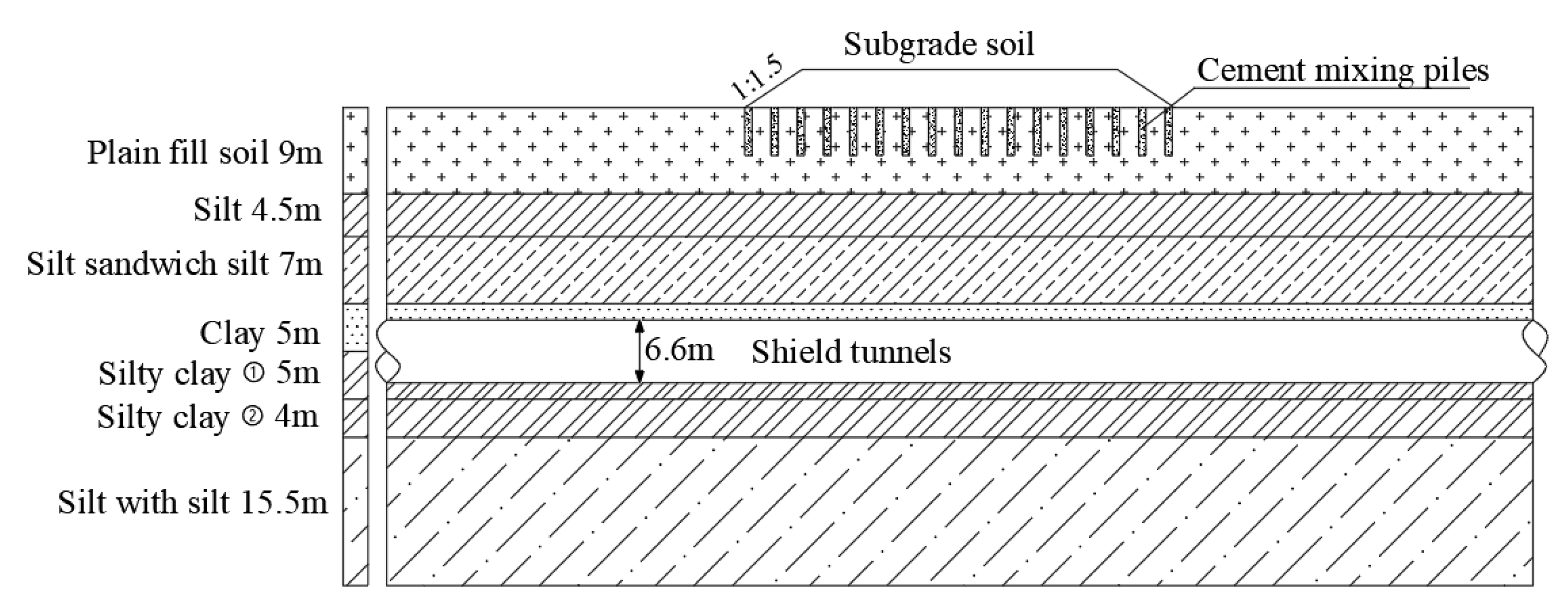
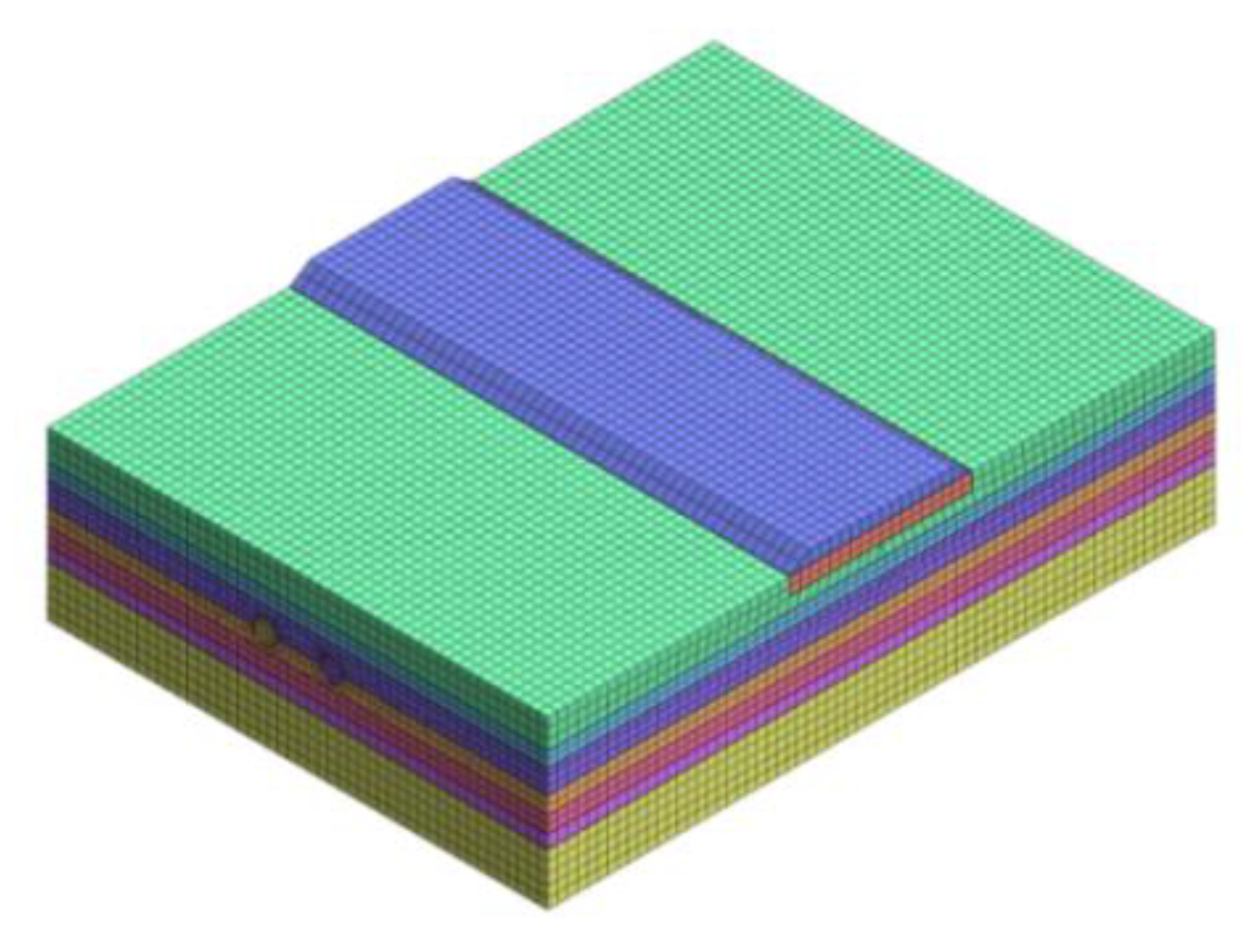
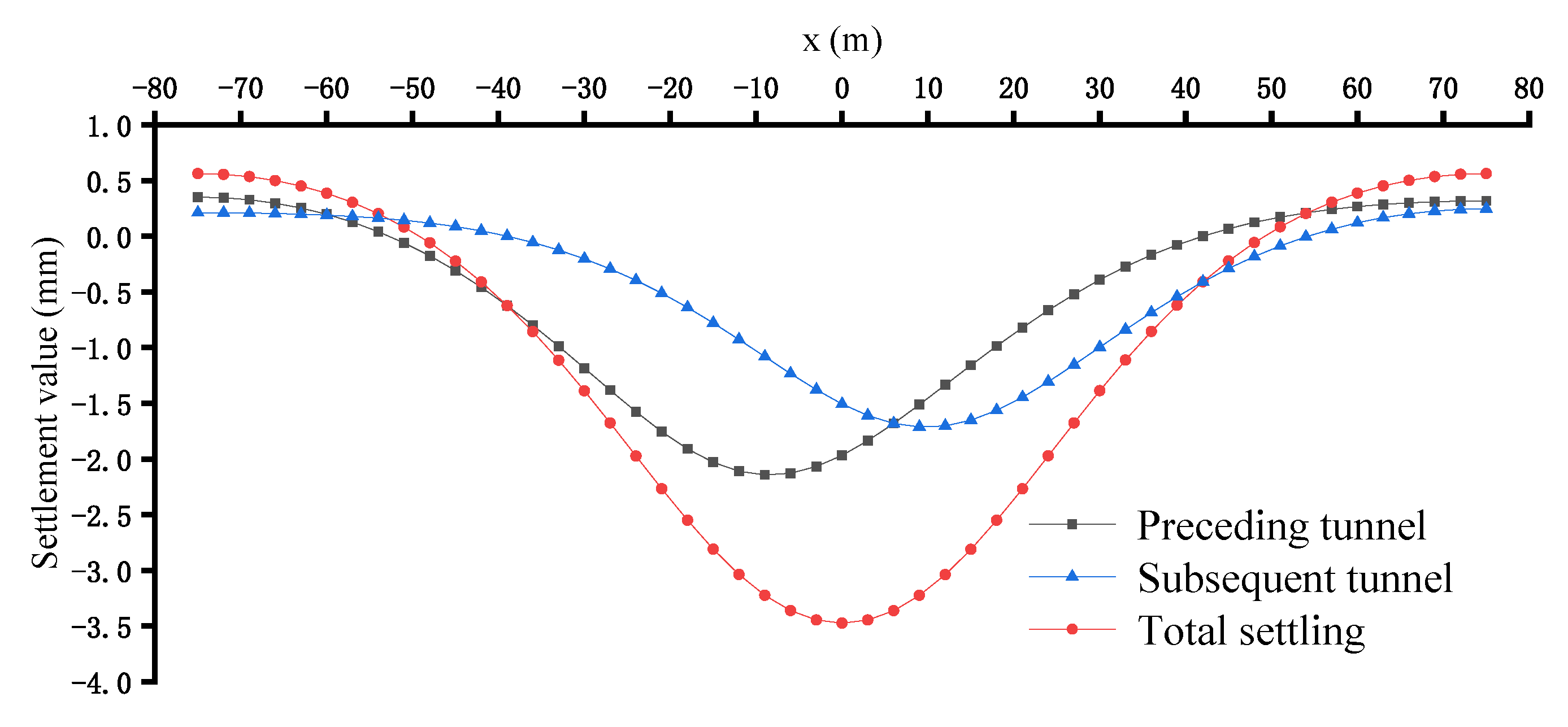

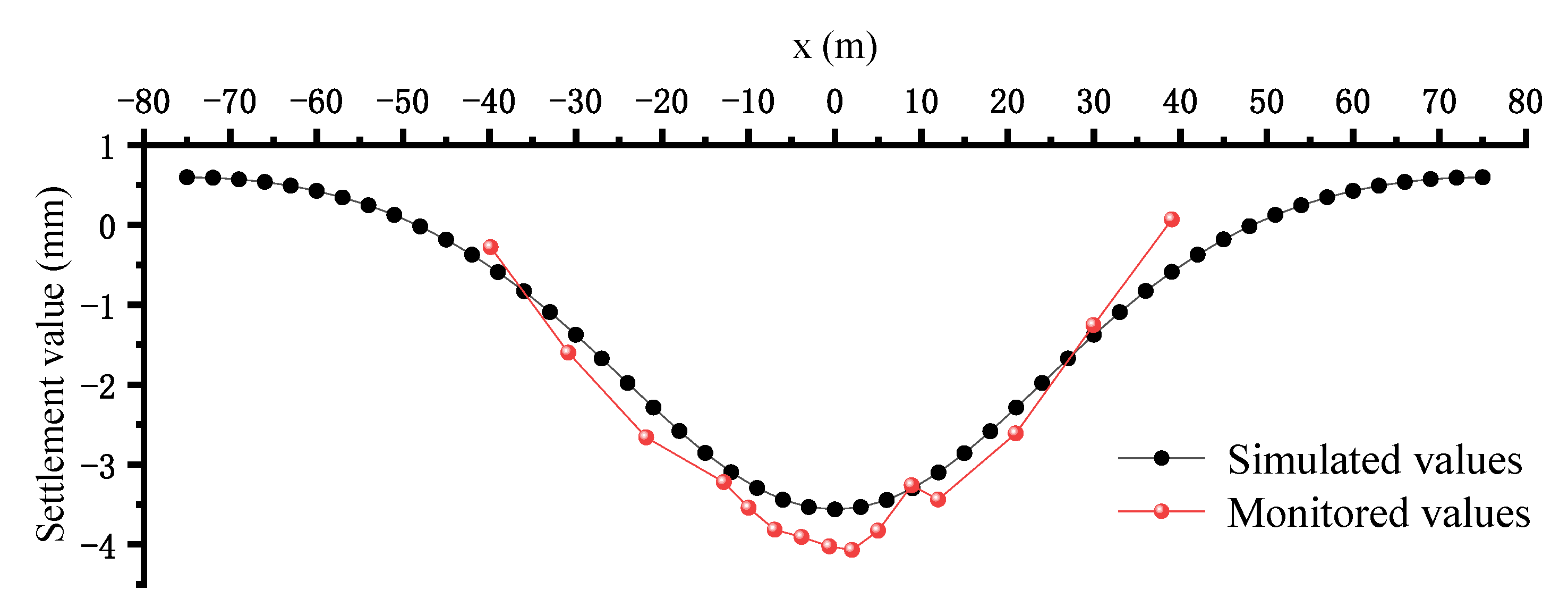

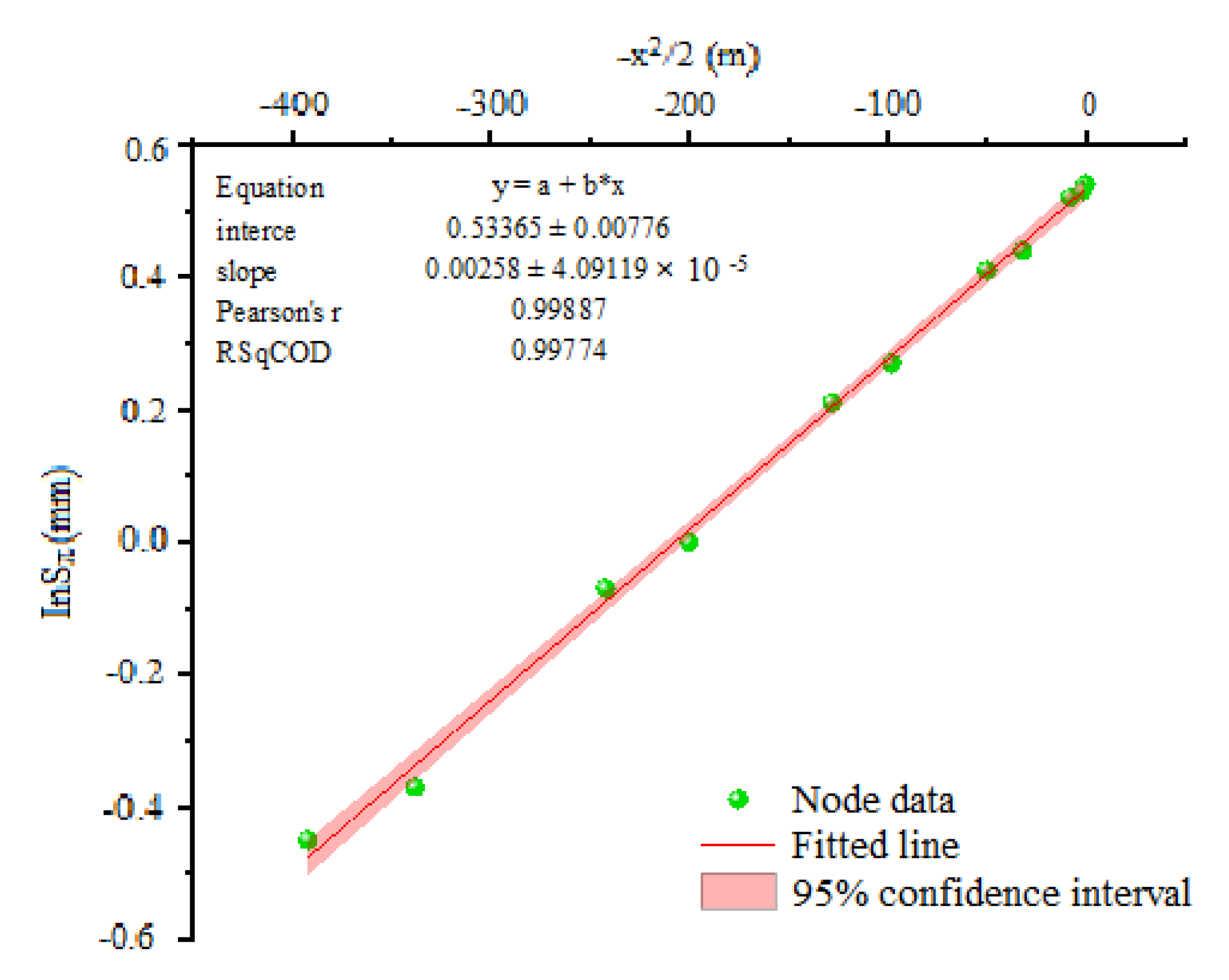

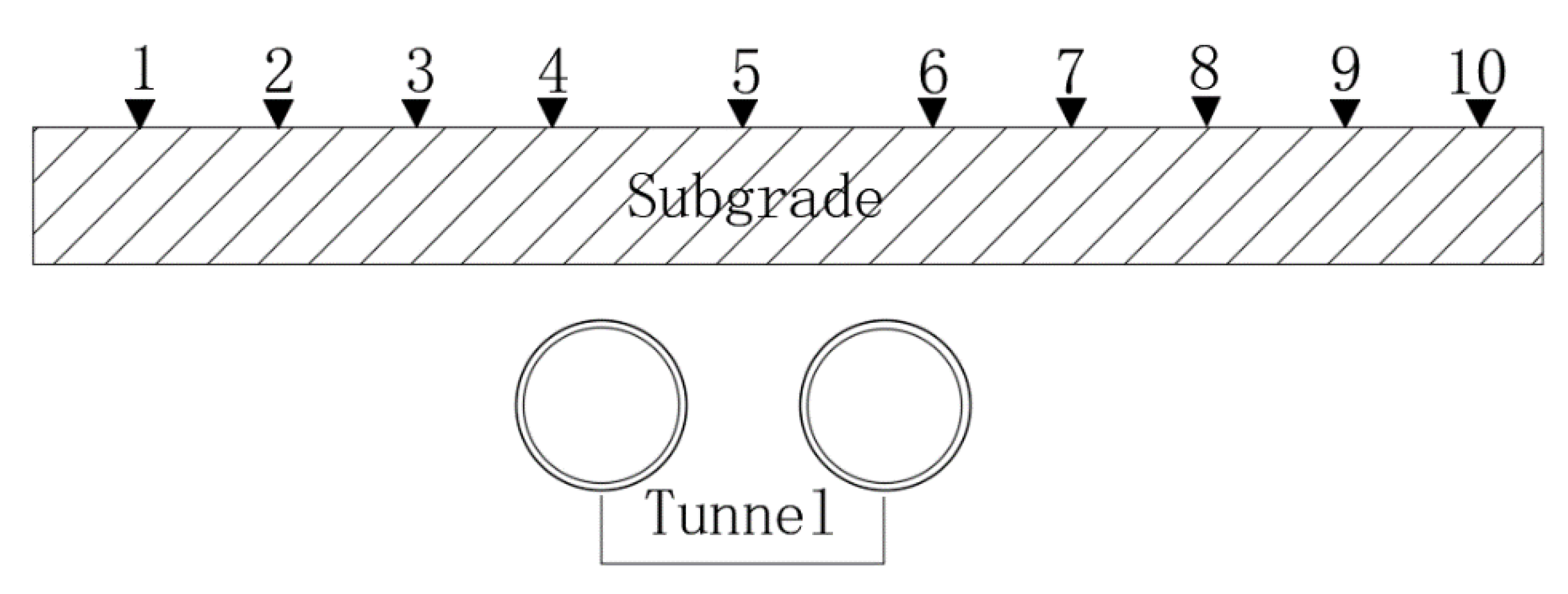
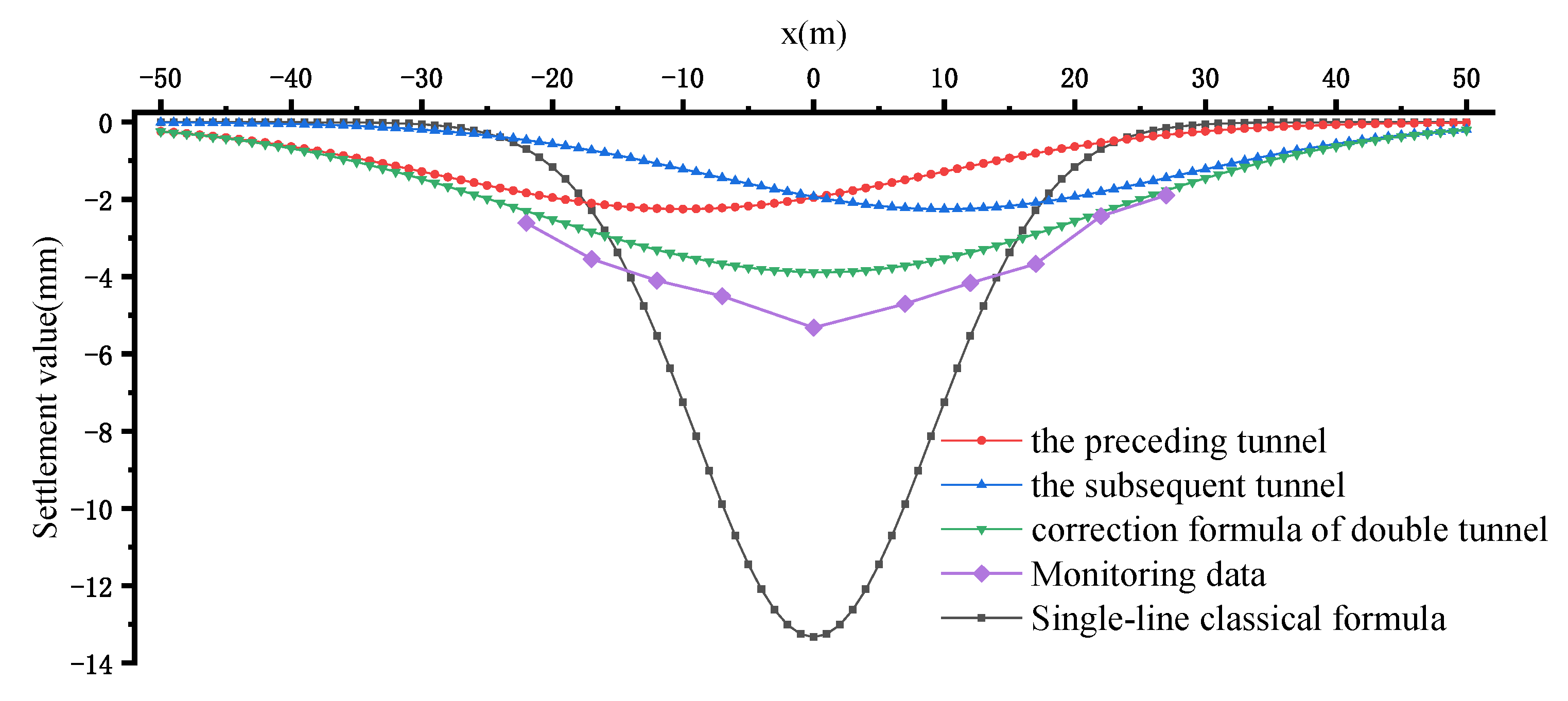
| Soil Layer Number | Soil Layer Name | Severe γ (kN/m3) | Compressibility | Stationary Side Pressure Force Coefficient K0 | Consolidate Quick Cuts | |
|---|---|---|---|---|---|---|
| Es1–2/(MPa) | Ck/(kPa) | Φk/(°) | ||||
| ①1 | Plain fill soil | 18.62 | / | 0.75 | 15.0 | 12.0 |
| ③1 | Clay | 19.40 | 7.55 | 0.43 | 46.9 | 15.7 |
| ③2 | Silty clay | 19.01 | 6.70 | 0.48 | 32.3 | 16.0 |
| ③3 | Silt | 18.72 | 10.53 | 0.45 | 7.1 | 25.0 |
| ④2 | Silt sandwich silt | 19.01 | 12.05 | 0.42 | 3.6 | 32.4 |
| ⑤1 | Silty clay | 18.82 | 5.58 | 0.60 | 27.9 | 15.3 |
| ⑥1 | Clay | 19.60 | 8.45 | 0.41 | 50.9 | 16.1 |
| ⑥2 | Silty clay | 19.11 | 6.97 | 0.45 | 31.9 | 15.0 |
| ⑦1 | Silty clay | 18.72 | 6.26 | 0.60 | 27.3 | 15.8 |
| Component | Unit Weight/(kN/m3) | Elastic Modulus/(kN/m2) | Poisson’s Ratio |
|---|---|---|---|
| Segment | 25 | 3.45 × 107 | 0.2 |
| Shield | 78.5 | 2.1 × 106 | 0.3 |
| Node | 1 | 2 | 3 | 4 | 5 | 6 | 7 | 8 | 9 | 10 | 11 |
|---|---|---|---|---|---|---|---|---|---|---|---|
| x | −26 | −20 | −14 | −8 | −2 | 1 | 4 | 10 | 16 | 22 | 28 |
| Sx | 0.80 | 1.19 | 1.58 | 1.91 | 2.11 | 2.14 | 2.13 | 1.98 | 1.68 | 1.34 | 0.99 |
| −x2/2 | −338 | −200 | −98 | −32 | −2 | −0.5 | −8 | −50 | −128 | −242 | −392 |
| lnSx | −0.22 | 0.17 | 0.46 | 0.65 | 0.75 | 0.76 | 0.76 | 0.68 | 0.52 | 0.29 | −0.01 |
| Node | 1 | 2 | 3 | 4 | 5 | 6 | 7 | 8 | 9 | 10 | 11 |
|---|---|---|---|---|---|---|---|---|---|---|---|
| x | −37 | −28 | −19 | −10 | −4 | −1 | 2 | 8 | 17 | 26 | 35 |
| Sx | 0.29 | 0.64 | 1.08 | 1.50 | 1.68 | 1.71 | 1.70 | 1.56 | 1.15 | 0.69 | 0.29 |
| −x2/2 | −685 | −392 | −181 | −50 | −8 | −0.5 | −2 | −32 | −145 | −338 | −613 |
| lnSx | −1.24 | −0.45 | 0.08 | 0.41 | 0.52 | 0.53 | 0.53 | 0.44 | 0.14 | −0.37 | −1.24 |
| Monitoring Point Number | x/m | Monitored Settlement Value/mm |
|---|---|---|
| 1 | −22 | −2.61 |
| 2 | −17 | −3.54 |
| 3 | −12 | −4.1 |
| 4 | −7 | −4.5 |
| 5 | 0 | −5.32 |
| 6 | 7 | −4.7 |
| 7 | 12 | −4.16 |
| 8 | 17 | −3.67 |
| 9 | 22 | −2.43 |
| 10 | 27 | −1.89 |
Publisher’s Note: MDPI stays neutral with regard to jurisdictional claims in published maps and institutional affiliations. |
© 2022 by the authors. Licensee MDPI, Basel, Switzerland. This article is an open access article distributed under the terms and conditions of the Creative Commons Attribution (CC BY) license (https://creativecommons.org/licenses/by/4.0/).
Share and Cite
Li, Y.; Lin, J.; Yan, S.; Du, J. Modification of the Peck Formula for a Double-Track Shield Tunnel under Expressway Subgrade. Symmetry 2022, 14, 1904. https://doi.org/10.3390/sym14091904
Li Y, Lin J, Yan S, Du J. Modification of the Peck Formula for a Double-Track Shield Tunnel under Expressway Subgrade. Symmetry. 2022; 14(9):1904. https://doi.org/10.3390/sym14091904
Chicago/Turabian StyleLi, Yuxiang, Juncen Lin, Songhong Yan, and Jiaxuan Du. 2022. "Modification of the Peck Formula for a Double-Track Shield Tunnel under Expressway Subgrade" Symmetry 14, no. 9: 1904. https://doi.org/10.3390/sym14091904





